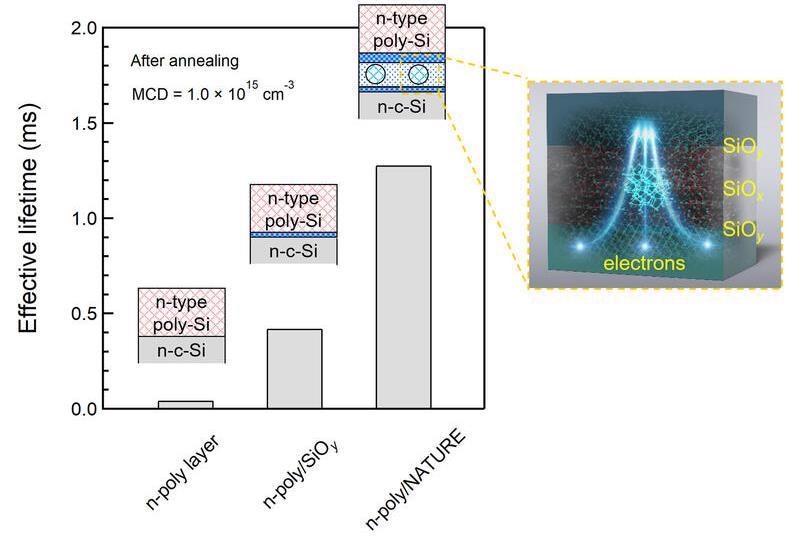In the future, decarbonized societies utilizing internet of things (IoT) devices will become commonplace. However, to achieve this, stable and highly efficient sources of renewable energy need to be realized.
 Effective lifetime of different structures. The insets show schematics of each sample and a magnified image of the NATURE contact. The highest effective lifetime is obtained for the sample employing the NATURE contact. Image Credit: ACS Publications.
Effective lifetime of different structures. The insets show schematics of each sample and a magnified image of the NATURE contact. The highest effective lifetime is obtained for the sample employing the NATURE contact. Image Credit: ACS Publications.
Solar cells are considered a useful option, but their electrical contacts experience a “tradeoff” relationship between conductivity and surface passivation. Recently, scientists from Japan have come up with a new kind of electrical contact that has the ability to overcome this issue.
The latest type of commercial photovoltaic cell (solar cell) makes use of the stacked layers of crystalline silicon (c-Si) and an ultrathin layer of silicon oxide (SiOx) for electrical contact to be developed. The SiOx is utilized as a “passivating” film — an unreactive layer that enhances the stability, reliability and performance of the device.
However, that does not mean that just increasing the thickness of this passivating layer will result in improved solar cells. SiOx is an electrical insulator and hence there is a trade-off relationship between passivation and the conductivity of the electrical contact in solar cells.
In a new study performed, a research group headed by Assistant Professor Kazuhiro Gotoh and Professor Noritaka Usami from Nagoya University has come up with a novel SiOx layer that concurrently enables enhanced conductivity and high passivation.
The study has been reported in the journal ACS Applied Nano Materials.
The electrical contact named as NAnocrystalling Transport path in Ultrathin dielectrics for REinforcing passivating contact (NATURE contact), comprises three-layer structures made of a layer of silicon nanoparticles fixed between two layers of oxygen-rich SiOx.
You can think of a passivating film as a big wall with gates in it. In the NATURE contact, the big wall is the SiOx layer and the gates are Si nanocrystals.
Kazuhiro Gotoh, Assistant Professor, Nagoya University
In solar cells, the conductivity of the electrical contact relies on the formation of a “carrier pathway” for the transport of electronic charges. The development of this electrical pathway is dependent upon a high-temperature treatment known as “annealing.”
Early work has displayed that SiOx contacts that consist of silicon nanoparticles as a carrier pathway could obtain good electrical properties. In the NATURE contact, the annealing process results in the formation of very small silicon nanocrystals in the passivation layer that almost appear to be spherical in shape.
The diameter of such nanocrystals complies with the thickness of the passivation layer. Therefore, by regulating the annealing conditions, the diameter and following thickness of the passivation layer could be adjusted.
The researchers fabricated NATURE contacts and further subjected them to differing annealing conditions. On studying the contacts with transmission electron microscopy, they found that silicon nanocrystals were developed in the contact at an annealing temperature of 750 °C.
Furthermore, they examined the electrical properties of the contact. They also noted that compared to existing contacts like the polysilicon on the oxide (POLO) contacts or tunnel oxide passivating contact (TOPCon), the NATURE exhibited comparable values of contact resistance and “recombination current.” It is a phenomenon that is responsible for current and voltage losses in solar cells and reduces their efficiency.
The NATURE contact overcomes the trade-off relationship between the protective ability and conductivity of passivating films. This development will lead to the realization of future building-integrated photovoltaics (BIPV) and vehicle-integrated photovoltaics (VIPV) and help us achieve zero-energy buildings and solar cars in future decarbonized societies.
Kazuhiro Gotoh, Assistant Professor, Nagoya University
Journal Reference:
Tsubata, R., et al. (2022) Silicon Nanocrystals Embedded in Nanolayered Silicon Oxide for Crystalline Silicon Solar Cells. ACS Applied Nano Materials. doi.org/10.1021/acsanm.1c03355.